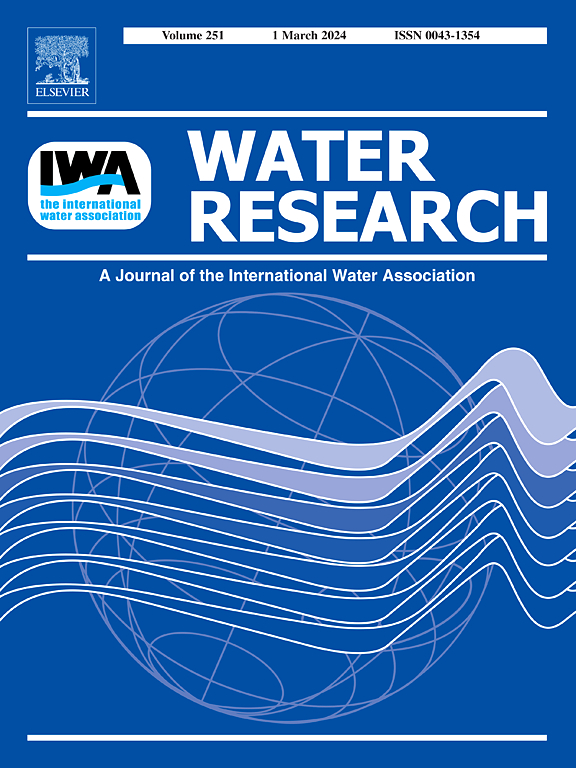Critical raw materials in river waters: First observation of lutetium microcontamination of the Isère and Rhône rivers, Southern France
IF 12.4
1区 环境科学与生态学
Q1 ENGINEERING, ENVIRONMENTAL
引用次数: 0
Abstract
The increasing use of rare earth elements and yttrium (REY) in enabling technologies is accompanied by their increasing release into the environment as emerging (micro-)contaminants. Starting with the detection of anthropogenic gadolinium (Gd) contamination in German rivers in 1996, currently available data on the distribution of REY in surface waters worldwide show anthropogenic positive Gd anomalies derived from Gd-based contrast agents used in magnetic resonance imaging, and at few locations positive La and Sm anomalies. However, in addition to the omnipresent positive Gd anomalies, the Isère River downstream of the city of Grenoble in southern France shows large positive lutetium (Lu) anomalies. These data which are confirmed by different analytical approaches in two different laboratories, are the first report ever of large positive Lu anomalies observed in surface waters. The very large size of the positive Lu anomaly most strongly suggests that this represents an anthropogenic Lu (micro-)contamination of the river. The origin of the anomalously high Lu concentrations can be tracked to the effluents from the wastewater treatment plant (WWTP) Aquapole in the city of Grenoble. This Lu is then diluted and hence decreases in concentration further downstream, but the anthropogenic Lu anomaly is still visible in REY data for the Rhône River. Repeated sampling over 15 months strongly suggests that the Lu (micro-)contamination of the Isère and Rhône rivers from the WWTP Aquapole is persistent and not a transient phenomenon related to a one-time event. The anthropogenic Lu shows natural isotope abundances and does not reflect pollution with radionuclides. The addition of Lu to the set of critical metals present as microcontaminants of the hydrosphere clearly reveals the necessity of better monitoring the distribution of REY and other formerly “exotic” elements and their release into the environment.


河水中的关键原料:法国南部is河和Rhône河中微量镥污染的首次观察
在使能技术中越来越多地使用稀土元素和钇(REY),同时它们作为新出现的(微)污染物越来越多地释放到环境中。从1996年在德国河流中检测到人为钆(Gd)污染开始,目前关于全球地表水中REY分布的现有数据显示,磁共振成像中使用的基于Gd的造影剂产生了人为的Gd阳性异常,并且在少数地区出现了La和Sm阳性异常。然而,除了普遍存在的Gd阳性异常外,法国南部格勒诺布尔市下游的is re河也显示出大量的lutetium (Lu)阳性异常。这些数据由两个不同实验室的不同分析方法证实,是地表水中观测到的大型正Lu异常的首次报告。非常大的正Lu异常非常强烈地表明这代表了河流的人为Lu(微)污染。异常高Lu浓度的来源可以追溯到格勒诺布尔市污水处理厂(WWTP) Aquapole的出水。然后,这种Lu被稀释,因此下游的浓度降低,但在Rhône河的REY数据中仍然可以看到人为的Lu异常。超过15个月的重复采样有力地表明,来自污水处理厂水孔的is河和Rhône河的微污染是持续的,而不是与一次性事件有关的短暂现象。人为Lu显示天然同位素丰度,不反映放射性核素污染。在作为水圈微污染物存在的一组关键金属中加入稀土元素,清楚地表明有必要更好地监测稀土元素和其他以前“外来”元素的分布及其向环境中的释放。
本文章由计算机程序翻译,如有差异,请以英文原文为准。
求助全文
约1分钟内获得全文
求助全文
来源期刊

Water Research
环境科学-工程:环境
CiteScore
20.80
自引率
9.40%
发文量
1307
审稿时长
38 days
期刊介绍:
Water Research, along with its open access companion journal Water Research X, serves as a platform for publishing original research papers covering various aspects of the science and technology related to the anthropogenic water cycle, water quality, and its management worldwide. The audience targeted by the journal comprises biologists, chemical engineers, chemists, civil engineers, environmental engineers, limnologists, and microbiologists. The scope of the journal include:
•Treatment processes for water and wastewaters (municipal, agricultural, industrial, and on-site treatment), including resource recovery and residuals management;
•Urban hydrology including sewer systems, stormwater management, and green infrastructure;
•Drinking water treatment and distribution;
•Potable and non-potable water reuse;
•Sanitation, public health, and risk assessment;
•Anaerobic digestion, solid and hazardous waste management, including source characterization and the effects and control of leachates and gaseous emissions;
•Contaminants (chemical, microbial, anthropogenic particles such as nanoparticles or microplastics) and related water quality sensing, monitoring, fate, and assessment;
•Anthropogenic impacts on inland, tidal, coastal and urban waters, focusing on surface and ground waters, and point and non-point sources of pollution;
•Environmental restoration, linked to surface water, groundwater and groundwater remediation;
•Analysis of the interfaces between sediments and water, and between water and atmosphere, focusing specifically on anthropogenic impacts;
•Mathematical modelling, systems analysis, machine learning, and beneficial use of big data related to the anthropogenic water cycle;
•Socio-economic, policy, and regulations studies.
 求助内容:
求助内容: 应助结果提醒方式:
应助结果提醒方式:


